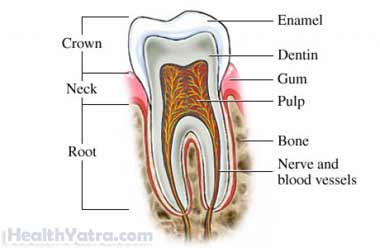Definition
This procedure removes dental pulp when it has become dead or infected. Dental pulp is the soft core of the tooth. It contains nerves, blood vessels, and connective tissue. The pulp extends from the top of the tooth, called the crown, all the way down to the roots, in branches called canals.

Reasons for Procedure
Dental pulp may become infected because of:
- An untreated cavity
- Trauma to the tooth
- Gum disease
When dental pulp becomes infected or dies, a painful abscess within the jawbone will occur. Removing dead or diseased dental pulp will prevent infection from spreading to other areas of the mouth and destroying bone around the tooth. If a root canal is not done, the tooth will need to be removed.
Common signs of pulp problems include:
- Pain when biting down on a tooth
- Pain when the tooth is not being used
- Sensitivity to hot or cold food or beverages
- Tooth discoloration
- Swollen gums around the infected tooth
- A draining boil-like structure (called a fistula) on the gum adjacent to the tooth
Possible Complications
Complications are rare, but no procedure is completely free of risk. If you are planning to have a root canal, your dentist will review a list of possible complications, which may include:
- Pain and swelling
- Surgical-wound infection
- Persistent abscess
- Inability to save the tooth
Factors that may increase the risk of complications include:
- Smoking
- Immune system disorders
- Bleeding disorders
- Circulatory problems that can cause healing problems (eg, diabetes)
Be sure to discuss these risks with your dentist before the procedure.
What to Expect
Prior to the Procedure
Your dentist will:
- Do a thorough dental exam
- X-ray your mouth—a test that uses radiation to take a picture of structures inside the body, especially bones
Anesthesia
Local anesthesia (eg, lidocaine ) will be used. The dentist will numb the area in your mouth. The anesthesia will be given as an injection.
Description of the Procedure
A small hole will be made through the top of the tooth and into the pulp. Next, steel files will be inserted to extract the pulp tissue. All teeth have 1-4 individual canals. Pulp will need to be extracted from all canals in the affected tooth. Once all pulp has been removed, the walls of the root canal will be reshaped and enlarged. Medicine will be inserted to kill bacteria.
At this point, the dentist may insert a temporary filling. This filling will protect the tooth. The procedure may be done within one visit or at multiple appointments. This depends on the condition of the tooth. Lastly, the canal will be dried, sterilized, and filled with a rubbery material. This material will prevent recontamination.
Immediately After Procedure
The dentist will:
- Permanently seal the area
- Place a gold or porcelain crown over the tooth to strengthen its structure
How Long Will It Take?
A root canal may take 1-3 appointments. Each appointment may last 1-2 hours.
How Much Will It Hurt?
You will have discomfort for a few days. Your doctor may give you pain medicine.
Post-procedure Care
When you return home, do the following to help ensure a smooth recovery:
- Be sure to follow your dentist’s instructions .
- Use warm, salt-water rinses to soothe your mouth.
- For a few days, avoid heavy biting and chewing on the side of the mouth that has the root canal.
- See your dentist for a follow-up x-ray as scheduled.
Call Your Doctor
After arriving home, contact your doctor if any of the following occurs:
- Signs of infection, including fever and chills
- Redness, swelling, increasing pain, excessive bleeding, or any discharge from the area around the tooth
- Tooth loosens after root canal treatment
- Headache, muscle aches, dizziness, or general malaise
- Pain that you cannot control with the medicines you have been given
In case of an emergency, call for medical help right away..
